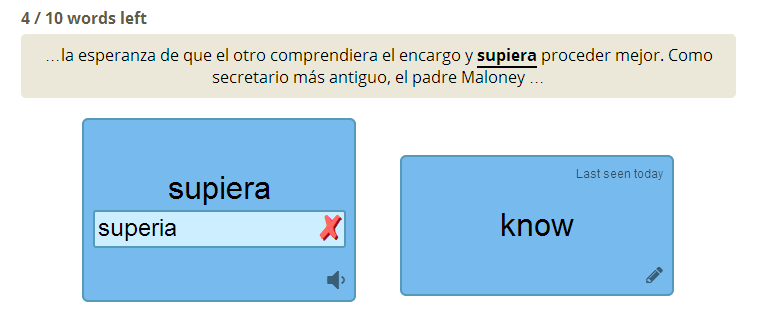The best way to read in the language you're learning
My Favorite Tools For Learning Spanish
November 28, 2014The best way to learn to speak Spanish is to just speak Spanish. Ideally with native Spanish speakers. But there’s also a lot you can do completely independently, and these are some of my favourite methods of self-study.
By the way, although I’ve focussed on Spanish, these methods are applicable for many languages.
1. Michel Thomas

This is a great place to start. It gives you a really good feel for the grammar, getting you to construct quite complex sentences from the very start, which really gets you motivated with the feeling of rapid progress. The format is unusual in that there are two other students on the CD who are learning alongside you and who will often fumble through an answer to be corrected firmly by Michel. It sounds strange but it really works. As with most language learning CDs, it’s best to actively participate, pausing after each question and speaking the answer aloud, or in your head, before listening to the student’s and Michel’s responses.
After finishing this course you should have developed a really good intuitive feel for the structure of the language, but will still have a very limited vocabulary.
2. Duolingo

Duolingo is an incredibly well made site, and it’s no wonder it’s become so popular so quickly. For someone who grew up with old Nintendo games the progress tree, hearts, lingots and other game-like elements really get me in the right frame of mind to level-up. And compared to the simple multiple choice questions of other learning websites, the free form text field you get to type your translations into is incredibly empowering. It gives you the feeling of genuinely being in command of the language when you translate a whole sentence correctly. The only downside is that it can be quite unforgiving and you may find yourself stuck at various points without an explanation how the grammar works. This is a minor niggle though since you can always look that elsewhere, and return to Duolingo to complete just… one… more… lesson…
3. Reading

Reading is a great way to assimilate the grammar, vocabulary and perhaps the culture, in an enjoyable and relaxing way. The trick is to find texts that you’re interested in at just the right difficulty. Here are some tips:
- Use books you’ve already read After reading a book in English, try re-reading it in Spanish. I did this a Roald Dahl kid’s book and with the first Harry Potter book and despite being a little above my level, I didn’t get too lost since I was already familiar with the characters and the story. (Also, I read it within Readlang which made it easier.)
- Parallel Texts These have Spanish on one page and English on the opposite page, so you can jump back and forth when the Spanish is proving too difficult. The problem is the lack of a good selection, I used this book of short stories which were useful although a little challenging for beginners.
- Google Translate A trick that some people use is to paste an article into google translate, and read it like a parallel text. Of course it won’t be of as high quality as a human translated text, but the massive advantage is that you can use for any text of interest to you.
- Click-to-translate The trouble with parallel texts and google translate is that they can become a crutch and make it too easy to rely on the English version. I prefer forcing myself to read the Spanish but to translate only the individual words and phrases that I don’t understand. I created the webapp Readlang to allow myself to comfortably read novels and other texts with tap-to-translate on my iPad, learn more about using Readlang to learn Spanish.
- Get recommendations from other learners Ideally from your friends or people with similar interests. You can also broswe the most popular Spanish websites read with the Readlang Web Reader on this page, online newspapers like El País take the top slots but there are other interesting options too:
- Cuentos Breves - Short stories for children
- Cuentosinfin - Classic short stories
- Wikipedia, la enciclopedia libre - The Spanish language wikipedia
- Spanish Podcast - Podcasts for Spanish learners with transcriptions
4. Flashcards
I’m not a fan of flashcards for most subjects, but when faced with the seemingly insurmountable goal of vocabulary learning, they are very useful. The most important aspect of a flashcard system, online or offline, is it must use an adaptive spaced repetition system to schedule your learning. This optimizes your time to make it possible to learn 1000s of words or phrases in a realistic period of time. The most popular online flashcard systems that do this are Anki and Memrise. Anki is open source and has apps for Windows, OS X, Linux, iOS and Android and and allows you to customize each flashcard with your own images, audio, and video. Memrise web-based and has iOS and Android apps, and allows users to contribute “mems” which are fun little images or sayings that help you remember a word.

I use my own flashcard system on Readlang, and I like it because it adds three key features compared to Anki and Memrise:
- Every word or phrase added to your list is one that you encountered naturally while reading, and actually clicked on to translate it, indicating that you didn’t understand it. This means that without any extra effort on your part, while reading you are compiling a list of words to learn in a subject that you are interested in.
- Each flashcard includes the sentence around the word for context. Context is very important both to disambiguate when a word may have multiple meanings, and to help form associations in your mind which is the key to remembering.
- When you practice the flashcards, the most frequently used words in the language are fed into the spaced repetition algorithm first. This ensures you optimize your time by focussing on the most useful words.
Thanks for reading, I hope this was useful. If you have any other recommendations for self-study methods for Spanish or other languages, I’d love to hear them!
PS: I didn’t intend to mention Readlang quite so much, but it makes sense since I’ve spent almost two years shaping it to my tastes.
Tweet comments powered by Disqus